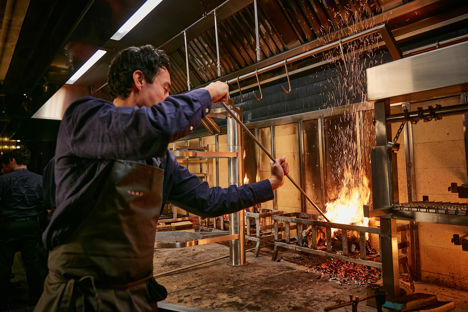
Miller Prada on the 5 woods we should be using on our barbecues
At his Mayfair restaurant HUMO, Miller Prada cooks solely over fire, cherry-picking different woods and cleverly using them to flavour his menu. He talks us through five types we can all use to level up our grilling.
Miller Prada on the 5 woods we should be using on our barbecues
At his Mayfair restaurant HUMO, Miller Prada cooks solely over fire, cherry-picking different woods and cleverly using them to flavour his menu. He talks us through five types we can all use to level up our grilling.
‘I see wood as an ingredient,’ Miller Prada says. ‘With wine, you can have the same type of grape but totally different expressions of flavour depending on different factors, and I see the same with wood. With oak, there’s English, French, oak that’s been under certain processes; it’s all totally different expressions of flavour. Wood is a key ingredient of a dish.’ Flames are flickering in the background as chefs at Miller's wood-fired restaurant HUMO get ready for lunch service. Its executive chef has taken an hour away from prep to talk all things wood, which, it's fair to say, has become something of a speciality over the last two years. While live fire cooking is certainly not a rarity in the capital, there are two things that set HUMO apart; firstly, its decision to cook everything over flames, and, secondly, its focus on the nuances of wood. Before the restaurant – which earned its first Michelin star this year – opened in early 2023, Miller spent the better part of a year combining woods and techniques to discover how to bring the best out of individual ingredients. ‘We believe that each species of tree has its own personality and characteristics,’ Miller explains. ‘We focus on how to use different techniques to extract that flavour into the food.'
Though those experiments included the likes of lemon and orange wood, today most types of wood used at HUMO are from around Britain, ranging from birch and beech to Scottish whisky barrels. Across his four-metre grill, chefs cook dishes at different heights and stations – while some ingredients benefit from a fiery flash of heat, others are smoked slowly and gently. HUMO's menu is inspired by the life of fire; its Ignite section, the first on the menu, focuses on raw fish and sashimi (Miller was a protegé of sushi master Endo Kazutoshi and his influence is evident), with some infused with a hit of smoke or quickly seared on wood. Elsewhere there's Smoke, a celebration of vegetables from the grill, Flame, where meat and seafood are grilled directly on wood (his Orkney scallop dish, which has become something of a signature, is cooked on and seasoned by whisky barrel wood), and Embers, where meat and fish are given more gentle treatment. ‘Everything on the menu has a relationship with trees, in one way or another,’ Miller says. ‘People usually believe that grilling is only one thing: putting things on top of the flames and charring, but we believe there is more.’ Here, Miller talks us through some of the woods we should be firing up on the barbecue this summer.
Silver birch
Silver birch – and applewood – are great if you're getting into wood-fired cooking, Miller says. The key is to wait until the wood has broken down into embers, you can let ingredients cook slowly or carefully cook delicate things on top (Miller adds smokiness to salad leaves or garnishes by putting them directly on top, for example). Miller advises starting with a bigger quantity of wood than you might think you’ll need to get enough embers.
English oak
A hardwood, English oak is long-lasting, dense and a popular choice for barbecuing. It gives off a lot of intense heat, so Miller says it great for grilling, charring and caramelising big pieces of meat. Its durability also makes it a good fit for longer cooks of big cuts of meat like beef and pork. It gives off plenty of smoke when it's first lit, though Miller says that can leave a bitter flavour; he prefers to wait until it's fully aflame before using it.
Juniper branches
Miller uses dehydrated juniper branches to smoke ingredients like seafood (at HUMO, it's used in a fourteen-day aged ike-jime Hampshire trout and caviar dish, pictured above). At home, he suggests loosely covering whatever you're cooking and throwing in some juniper branches to your barbecue at the end of cooking – it will infuse it with smokiness as a finishing touch.
Whisky barrel
Aim for wood from barrels that you can trace the source of – there are commercial whisky barrels available, but Miller says they tend to have less flavour. Light the wood and then when the fire has died down and the barrels have turned white, you can cook ingredients directly on them, like shellfish (as HUMO does with its scallop dish). It imparts an earthy flavour, with notes of vanilla and dark chocolate.
Grape wood
Grape wood is the newest addition to Miller's kitchen, having been added to the menu a few months ago. Its smaller size initially presented a challenge, but, having got to grips with it, Miller now touches it on raw fish to gently sear it, inspired by the Japanese aburi technique (at HUMO, it's used in their sea bass dish, served with a Marinda tomato 'dashi', capers, white sesame, pink radicchio and Kinome). It has a sweet and aromatic smoke profile that can be used sparingly to avoid overpowering other flavours.
Feeling inspired to start experimenting with different woods? Put Miller's tips into practice with one of our incredible barbecue recipes.


